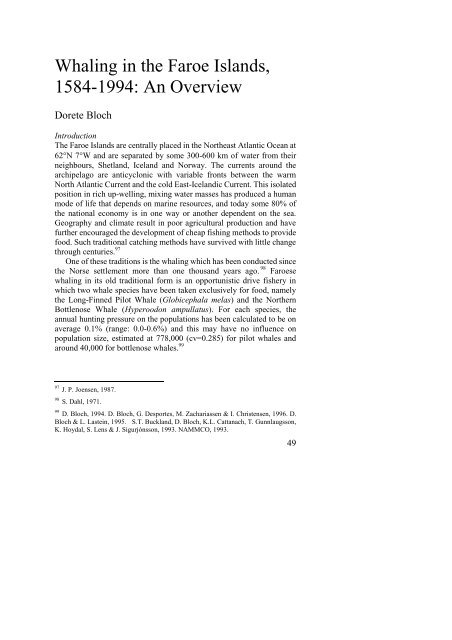The North Atlantic Fisheries, 1100-1976 - University of Hull
The North Atlantic Fisheries, 1100-1976 - University of Hull
The North Atlantic Fisheries, 1100-1976 - University of Hull
You also want an ePaper? Increase the reach of your titles
YUMPU automatically turns print PDFs into web optimized ePapers that Google loves.
Whaling in the Faroe Islands,<br />
1584-1994: An Overview<br />
Dorete Bloch<br />
Introduction<br />
<strong>The</strong> Faroe Islands are centrally placed in the <strong>North</strong>east <strong>Atlantic</strong> Ocean at<br />
62N 7W and are separated by some 300-600 km <strong>of</strong> water from their<br />
neighbours, Shetland, Iceland and Norway. <strong>The</strong> currents around the<br />
archipelago are anticyclonic with variable fronts between the warm<br />
<strong>North</strong> <strong>Atlantic</strong> Current and the cold East-Icelandic Current. This isolated<br />
position in rich up-welling, mixing water masses has produced a human<br />
mode <strong>of</strong> life that depends on marine resources, and today some 80% <strong>of</strong><br />
the national economy is in one way or another dependent on the sea.<br />
Geography and climate result in poor agricultural production and have<br />
further encouraged the development <strong>of</strong> cheap fishing methods to provide<br />
food. Such traditional catching methods have survived with little change<br />
through centuries. 97<br />
One <strong>of</strong> these traditions is the whaling which has been conducted since<br />
the Norse settlement more than one thousand years ago. 98 Faroese<br />
whaling in its old traditional form is an opportunistic drive fishery in<br />
which two whale species have been taken exclusively for food, namely<br />
the Long-Finned Pilot Whale (Globicephala melas) and the <strong>North</strong>ern<br />
Bottlenose Whale (Hyperoodon ampullatus). For each species, the<br />
annual hunting pressure on the populations has been calculated to be on<br />
average 0.1% (range: 0.0-0.6%) and this may have no influence on<br />
population size, estimated at 778,000 (cv=0.285) for pilot whales and<br />
around 40,000 for bottlenose whales. 99<br />
97 J. P. Joensen, 1987.<br />
98 S. Dahl, 1971.<br />
99 D. Bloch, 1994. D. Bloch, G. Desportes, M. Zachariassen & I. Christensen, 1996. D.<br />
Bloch & L. Lastein, 1995. S.T. Buckland, D. Bloch, K.L. Cattanach, T. Gunnlaugsson,<br />
K. Hoydal, S. Lens & J. Sigurjónsson, 1993. NAMMCO, 1993.<br />
49















